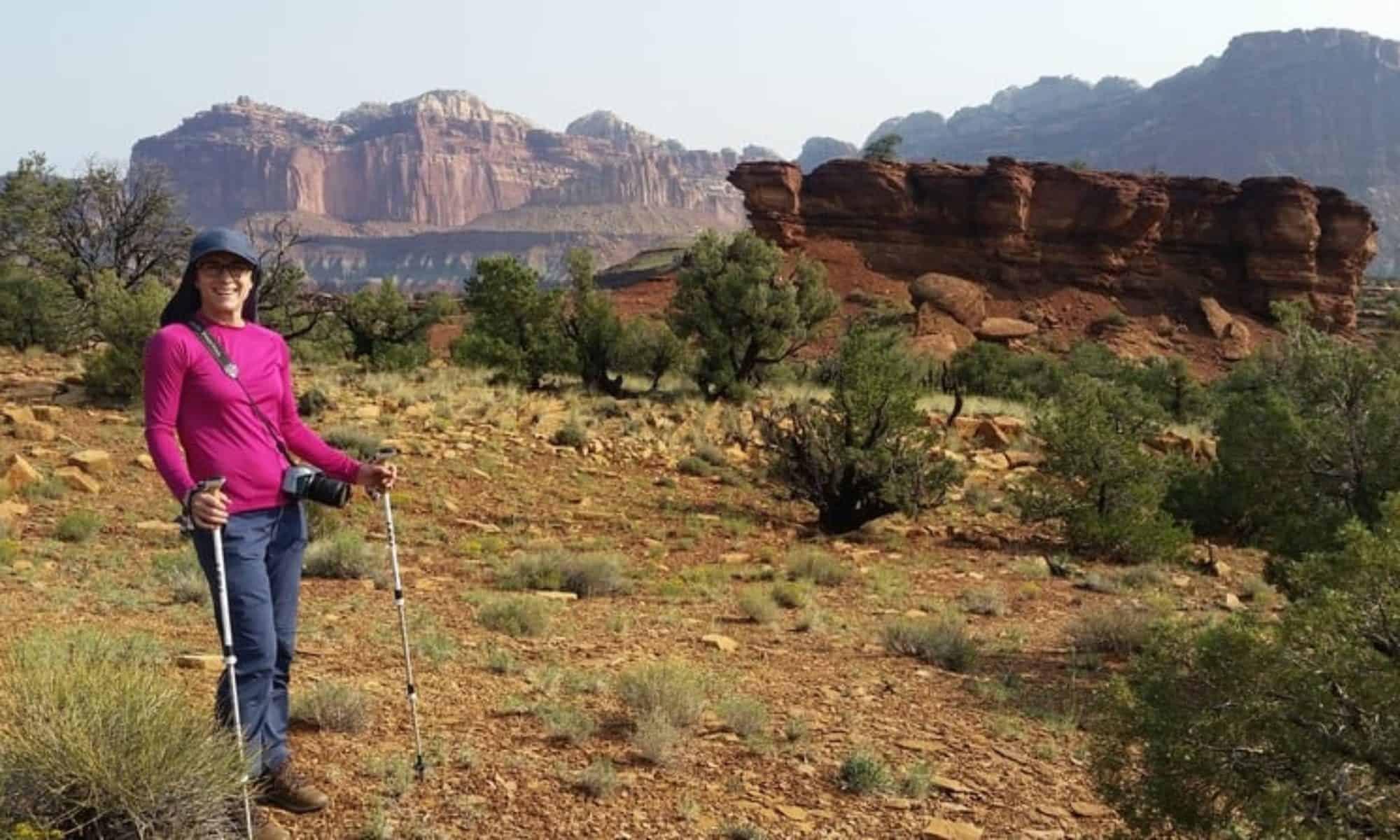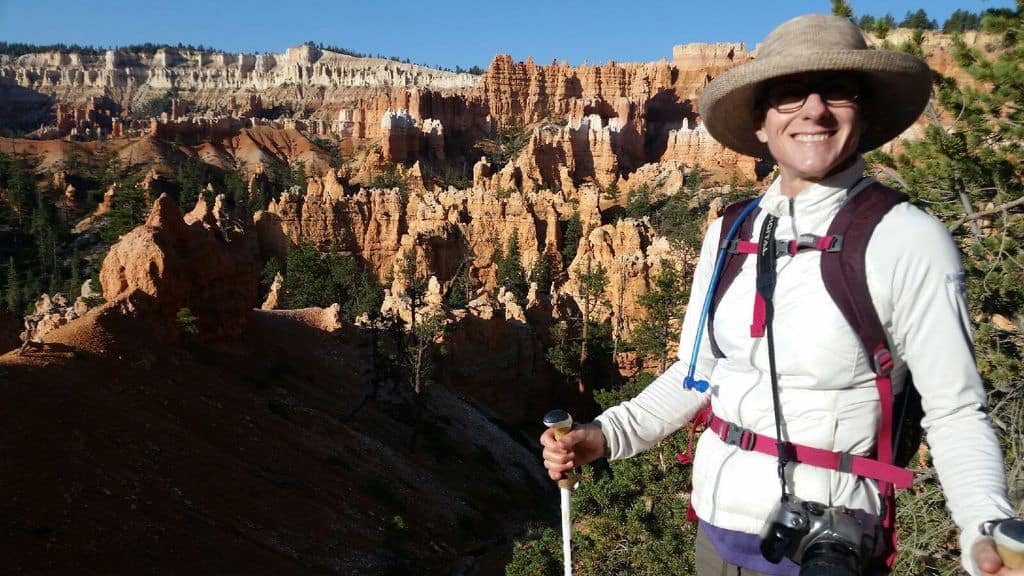
In writing these blogs I hope to not only educate you a little but also inspire you to get out and try some new activities. Not only for the exercise but for your mental health and enjoyment. Hiking is one of those activities that I think most anyone can enjoy, as long as you have some essential gear!
I know that many of you will never try hiking because you physically can’t (or think you can’t), or you just don’t think it sounds like fun. But if you can walk then I want to encourage you to try it anyway. Even if you don’t become a regular hiker it might be worth it to try it this time of year when you can take advantage of the near-perfect weather and beautiful fall colors!
I can’t tell you how many times I tried something new and ended up loving it! Snowmobiling, dancing, and biking to name a few. It’s also how I figured out which exercise equipment I hated and what worked for me. And like exercise, if you don’t have the right equipment the experience just isn’t as enjoyable.
So this is my own list of 7 hiking essentials that I can’t live without. We all know that athletes need the right shoes and clothing, but hikers aren’t any different. Before investing much money though you should first try going on some short hikes with what you’ve got. That way you’ll know why it matters to be properly prepared! And maybe you’ll even decide it doesn’t matter for your purposes.
Related article: “Hiking vs walking: how you can benefit from both“.
My list of essentials
Although other hikers may have different ideas about what’s necessary, this is my basic list. It’s really not a long list, I mean you have to wear clothing, socks and shoes anyway! But as I talk about each I’ll tell you why I consider them “essential” for hiking.
-
- Comfortable shoes/boots
- Hiking sticks
- Good socks
- A backpack or water/food carrier
- A hat
- Comfortable clothing
- First Aid kit
Comfortable shoes/boots
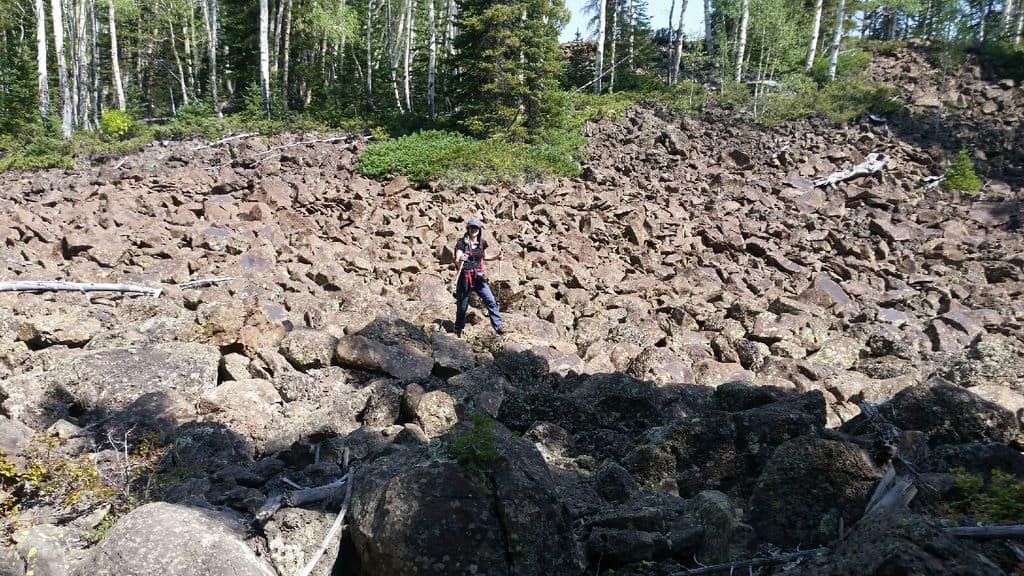
I’m putting this first on the list because in physical activities or sports of any kind shoes are the most important item. If your feet aren’t protected or comfortable then you’ll hate every minute of what you’re doing.
I think it’s a good idea to have ankle support while hiking because of the uneven terrain, so I prefer (short) boots over shoes. Some people prefer shoes because they keep their feet cooler and others just don’t like their ankles being bound up. The choice is yours, just be sure you try them on and test them out at home before committing to them long-term.
My first pair of hiking shoes were Merrell’s Moab 2 mid boots and I loved them! They’re also waterproof which I think is essential for hiking boots. You never know what weather you’ll run into or if there are waterways you’ll have to cross.
I’m a size 8 so that’s what I got in my Merrells because I didn’t know any different. But it’s often recommended to get a half size up so when you’re feet swell (as they do the longer you’re on them) you’ll still have plenty of room. I wish I had known that when I first bought them because that would’ve helped.
I’ve seen people hiking in all types of shoes, including flip-flops, but I don’t think it’s very smart! Boots help to keep your ankles supported so you don’t sprain one on the uneven surface. But they’re also sturdy enough to protect your toes and the bottoms of your feet from injury and bruising.
Recently, I bought a different brand because I wasn’t finding Merrell’s that I liked with specific features I was hoping for. I ended up getting these Timberland boots that I’m very happy with so far. But because they’re fairly new to me I can’t give you a long-term review on them.
Either way, I would say that a comfortable, sturdy pair of boots is a hiking essential and should be the first thing you buy!
Hiking sticks are more helpful than you think!
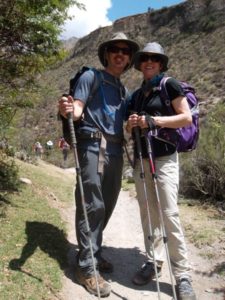
When we first started hiking we didn’t use sticks. But then we took a trip to Peru to hike the Inca Trail to Machu Picchu and found out how helpful they are! Our guide made us use them there because, thankfully, he knew better. And we learned quickly that they really give you a lot of extra support, especially on hills.
Going up hills or steps you can plant them ahead of you so you can use your arms to help pull yourself up. That eases up on your leg muscles which get very tired when they’re doing all the work! Then going downhill you plant them below you to help ease the pressure on your knees. We’ve found that going downhill is just as hard as up, it’s just different.
After that, we invested in hiking poles, which are also called sticks. My sticks are the Leki Cressida trekking poles and I love them too! They’ve lasted 7 years now and nothing has broken or bent on them. I especially like the cork hand grips because they’re always comfortable, even when it’s hot out.
We see people out hiking all the time in the mountains without them and I just shake my head at the extra effort they’re putting in! But even our little hills in Iowa are much easier to hike with them. They also help for balance when you’re on uneven ground. So if you’re interested in safety, I would highly recommend them.
Related article: Don’t let age define you!
Who knew socks could be so important?!
Another little helpful piece of information that I learned while hiking the mountains of Peru was the importance of the right socks! I only had a few pairs of wool hiking socks at the time so I took one pair of cotton socks. I didn’t think it was a big deal but I wore them the first day and wanted to throw them out after that!
It was a hot day and my feet sweat, which happens even if it’s not hot out by the way. Well, when cotton socks get wet they don’t dry. Instead, they just stick to your feet and rub on your skin! All I could think of for hours was getting my boots off and putting my feet in cold water!
Thankfully I didn’t get blisters but I’ve never worn cotton socks while hiking again. Wool socks are generally recommended for hiking. So I started stocking up mostly on the Smartwool brand. They come in cute colors and designs and they’re easy to find in many stores. They also last a long time.
More recently I’ve discovered the brand Darn Tough which are made in the USA (bonus!) and have a lifetime guarantee! So even though they seem really expensive, they’re worth it for the comfort you’ll get from them. And who gives a lifetime guarantee on anything anymore?!
Most hikers have learned that socks are another hiking essential because your feet are the most important part of your body. Do not take them for granted!
Backpack or fanny pack?
If you’re hiking close to home or civilization a fanny pack will most likely work just fine for carrying some extras. But if you’re venturing out further into the wilderness then you’ll want a backpack. This is on my list of hiking essentials because there are lots of items you may want just in case, such as:
-
- water (which is essential any time you’re hiking!)
- snacks
- lip balm
- storage for car keys
- a first aid kit
- a knife
- matches
- toilet paper
- a raincoat (just in case)
- extra room for extra layers of clothing
- and who knows what else!
The more you hike the more things you’ll realize you want with you, like I said, “just in case”!
The backpack
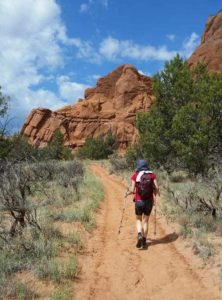
Unless you decide you want to do overnight trips a small backpack (called a daypack) should work fine for most hikes. And if you’re near home with predictable weather then you may not need a bunch of extra stuff. But if you’re out in the mountains the weather can change in a heartbeat so you need to be prepared for anything!
We’ve had rainstorms move in over the mountains after we started a hike in the sun. So you should pack a raincoat. We’ve also started out in the cold then had the sun and heat take over within an hour of hiking. So you might want to take off some layers. My point is that you need to plan for every possible situation and be sure to get advice from locals.
The small backpacks we got many years ago and still use today are Camelbaks. We’ve had them for at least 7 years now and there’s barely any wear on them, so they last. You just need to make sure they fit comfortably so try them on in a store before buying.
We like them because they hold the 2 liter Camelbak water bladders in a pouch in the pack. There’s a hose that feeds out of the backpack and attaches on the front of the pack for easy sipping. We find these so much more convenient than dealing with water bottles!
Water is a necessity when you’re hiking or doing any outdoor activities. If you’re not used to carrying it with you yet, then you need to get in the habit. Besides, if you were injured while out hiking and couldn’t get back then you want extra to get you through a day or night. We don’t always drink all of our water on hikes but we do always fill the containers.
The perfect hat
In my opinion, a hat for sun (or rain) protection is another essential. I see many people out hiking without a hat but since my mother got skin cancer on her head, in her hairline, I take it seriously! We can’t put sunscreen on our heads, or we don’t usually, so wearing a hat is just smarter.
A hat isn’t just to protect your skin but your eyes too. As I’ve gotten older I’m not a fan of the sun shining right down inside my sunglasses. If you don’t like hats that’s your choice but I never go without one.
I have several hats that I use but something like this Muryobao hat would be perfect for hiking! I love the large brim, the ponytail hole and the tie under your chin to keep it securely on your head (essential when it’s windy!). Plus, it comes in 14 colors!
I don’t own this hat so don’t take my word for it, but it sure is cute and looks like it has everything I would want for hiking.
Comfortable clothing
“Comfortable” is a very subjective word. But you should know that when you’re hiking you may be brushing up against weeds and stickers so I prefer long pants. I don’t like feeling itchy or getting bug bites, so pants are essential for me.
Since I’ve been hiking a while I’ve come up with certain requirements for the pants I choose to wear. They need to be lightweight, I want to wear them without a belt, they need to have pockets, and they need to be wide enough at the bottom to go over my boots. Experience is a good teacher!
Lightweight is important because you will usually get hot while hiking. I don’t like wearing a belt and a backpack at the same time because it’s too much around my waist. I like pockets for things like maps, my phone or my lip balm. And if they’re not wide enough to go over the tops of my boots then seeds and other things get into my boots and bother me!
So Columbia pants have served me well over the years and a great pair to get would be the “convertible” pants that zip off. That way you have the option to make them shorter if you want. Finding the right fit is the hard part! Just like shoes, they have to be pretty perfect. And that may take some trial and error.
Tops
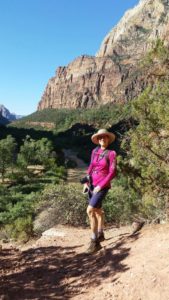
This is also a matter of personal preference but one thing I do recommend is wearing a top that is moisture-wicking. If it’s cold you may be OK in cotton, but when it’s warm it just gets wet and holds the moisture on your skin. Not fun! All I can say with hiking is that you will probably sweat so you should be prepared!
Most of my tops are the short-sleeved Columbia Omni-wick type because we mostly hike when it’s warmer out. When it’s cooler I like long-sleeves so I recently bought a Columbia PFG long-sleeved shirt. I also really like this as an option instead of having to wear sunscreen all the time.
These shirts are very lightweight so even when it’s hot out you can wear the long-sleeves for better sun protection. But whether you’re a hiker or not, they’re great for walking on cooler days.
Think about a vest
Jackets or vests aren’t always essential gear depending on when or where you’re hiking but I would recommend them in the mountains. Because the weather can change so quickly you want to be prepared. I’ve also hiked in many areas where it’s cold right away in the morning but warms up quickly.
A vest is one of those items that will keep your core warm but let your arms breathe a little so you don’t get too hot. I got a Columbia vest years ago that has been great for hiking especially because it’s just enough coverage. I’ve also worn it at night sleeping when it gets cold on camping trips!
I prefer the polyester fabric because it’s at least water-resistant and weeds won’t stick to it. Fleece is nice to touch but not as practical in my opinion.
Don’t leave home without a first aid kit
If you’re going to be really close to home and on a fairly short hike then this may not be necessary. But I take one anyway, just to be safe. You never know when you might cut yourself, get stung by a bee, or sprain an ankle. And if you’re by yourself without anyone to help then this might be a lifesaver.
I can remember my husband and I out hiking once in the early days and having it dawn on both of us that we were totally unprepared for any emergencies! A small first aid kit for backpacking and outdoor activities is cheap and easy to bring along. Better safe than sorry.
My final thoughts
Hiking is just another fun activity that gives me great exercise and a mental health boost every time I go out. If you want motivation to exercise then it helps to adopt active hobbies that you can enjoy by yourself or with others.
I think it’s important to realize why specific gear is recommended for every activity. It makes the experience more enjoyable and keeps you safe. And although this is my specific list of hiking essentials, it may not be yours. But hopefully, I’ve given you some things to think about.
My advice for hobbies is to choose an activity that you might first love just for the experience. Then the exercise you get from it is a bonus! I love the outdoors and nature so I enjoy that part. I also love taking pictures of the beautiful places we visit so that makes it even more fun.
Enjoying your time is what makes life worth living. But being an exerciser makes life easier to live. Try combining the two for a better quality of life! If you’d like to train with me so you can feel more confident getting out hiking then check out my personal training service.
